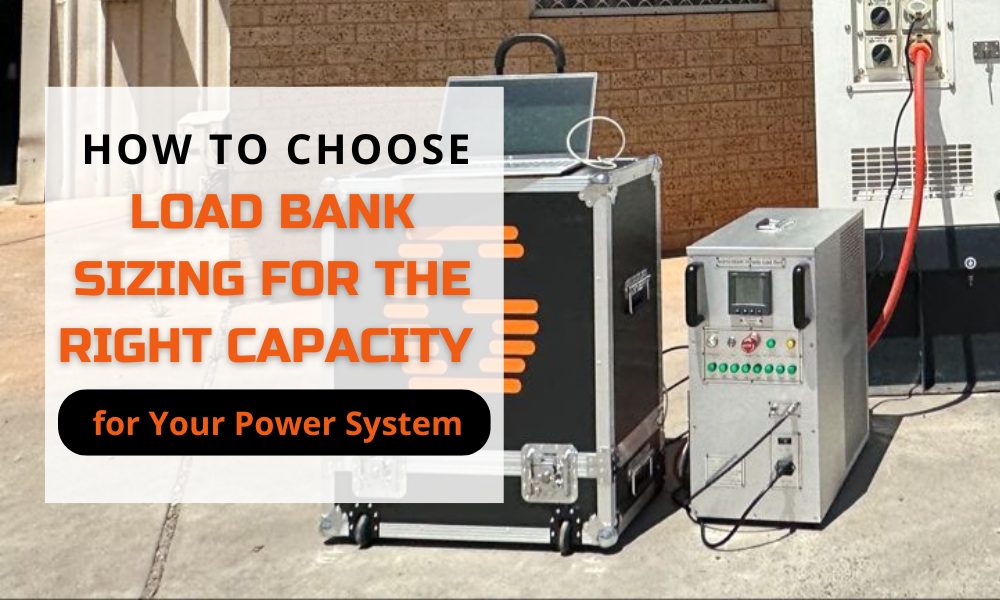In power generation, ensuring optimal performance and reliability is paramount. A load bank is a crucial tool and plays a pivotal role in testing and maintaining the efficiency of power systems by providing a simulated electrical load.
However, selecting the appropriate load bank sizing is crucial to ensure accurate testing and prevent potential system damage. Let’s take a closer look at the essentials of load bank sizing and how to choose the right capacity for your power system.
Understanding Load Banks
Load banks are devices designed to provide an electrical load to mimic real-world operating conditions for generators, uninterruptible power supplies (UPS), turbines, and other power sources. By subjecting the system to a controlled load, load banks enable testing, commissioning, and maintenance activities.
Importance of Load Bank Sizing
Load bank sizing involves determining the appropriate capacity of the load bank relative to the power system being tested. An improperly sized load bank can result in inaccurate testing, potential equipment damage, and compromised safety. Therefore, selecting the right load bank capacity is critical for reliable and effective testing procedures.
Factors Influencing Load Bank Sizing
Several factors should be considered when determining the appropriate load bank size for your power system:
- Power System Capacity: The rated capacity of your power system is a primary factor in load bank sizing. The load bank should be capable of handling the maximum load that the system can generate.
- Application and Testing Goals: Consider the intended purpose of testing and the specific parameters you aim to evaluate. Different applications may require varying load capacities and configurations.
- Voltage and Current Ratings: Ensure that the load bank’s voltage and current ratings align with those of the power system to avoid overloading or underloading.
- Duty Cycle: Evaluate the expected duty cycle of the load bank, including continuous, intermittent, or peak loading conditions. The load bank should be capable of sustaining the desired load over the intended duration.
- Environmental Conditions: Take into account environmental factors such as ambient temperature, altitude, and humidity, which can affect the performance of the load bank.
Calculating Load Bank Sizing
The process of determining the appropriate load bank size involves careful calculation and consideration of various parameters:
- Total Load Capacity: Calculate the total load capacity of the power system by summing the power ratings of all connected loads, including motors, lights, air conditioning systems, and other equipment.
- Load Bank Rating: Choose a load bank with a capacity equal to or slightly greater than the total load capacity of the power system. It’s advisable to have some margin for additional testing or future expansions.
- Power Factor: Consider the power factor of the load bank and the power system to ensure compatibility and accurate testing results. Adjustments may be necessary to account for reactive power components.
- Voltage Regulation: Verify that the load bank can maintain stable voltage regulation within acceptable limits under varying load conditions.
Types of Load Banks
Load banks come in various types and configurations, each suited for specific applications and testing requirements:
- Resistive Load Banks: Ideal for testing power systems with purely resistive loads, such as heating elements or incandescent lights. Resistive load banks provide a constant, linear load without introducing reactive power.
- Reactive Load Banks: Designed to simulate inductive or capacitive loads, reactive load banks are used to test power factor correction systems and evaluate the reactive power capabilities of generators and transformers.
- Combination Load Banks: Combining resistive and reactive elements, combination load banks offer versatile testing capabilities for comprehensive assessments of power systems.
Need Load Bank Advice: Contact the Team at GHASA
Selecting the right load bank sizing is essential for accurate testing, maintenance, and performance evaluation of power systems. Whether testing generators, UPS systems, or turbines, investing in the appropriate load bank sizing ensures reliable and efficient operation of your power generating equipment.
With the right load bank sizing, you can power your systems with confidence and reliability. With a wide range of load banks for sale and hire in Perth, australia, we are dedicated to helping you find the right load bank for your job.
Contact us today on (08) 9359 1988 or visit ghasa.com.au to learn more about our comprehensive range of load banks and expert technical support.


